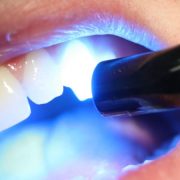Tooth decay, also known as dental caries is meant by a progressive breakdown, destruction, or damage to the enamel (hard outer covering of the tooth). If left untreated the infection can spread to the deeper layers of the tooth such as the pulp (innermost, nourishing layer of the tooth consisting of nerves and blood vessels) causing pain and discomfort.
Richmond Family Dentistry offers a comprehensive approach to tooth decay in kids by providing treatment based on the severity of the symptoms and the extent of decay.
What causes tooth decay?
Your mouth consists of microflora which is a community of bacteria. Cavity-causing bacteria combine with the food you eat to form a thin, sticky biofilm on the tooth surface known as dental plaque. The bacteria in the plaque combine with the sugary foods and drinks to form harmful toxins, acids, and by-products. These acids and by-products demineralize your tooth. Over time, plaque can harden to form calculus (tartar) that can worsen tooth decay.
What are the signs & symptoms of tooth decay in children?
The common signs and symptoms based on the stage include:
Early Tooth Decay
- Initially, white spots appear to form on the teeth in the affected areas.
- A pit or tiny hole (cavity) may begin in the affected area. This may appear yellow, or light brown.
- The gums around the affected tooth may be red and swollen.
Advanced Tooth Decay
- The cavity may enlarge and widen, spreading into the deeper areas of the tooth, such as the pulp.
- The color of the tooth decay gradually turns from brown to black.
- The tooth may begin to break due to increased demineralization.
- Infected tooth cavities may cause pain and discomfort.
- There is increased tooth sensitivity to hot and cold foods.
- Halitosis (bad breath) with increased gingival swelling, redness, and bleeding.
What are the treatment options for tooth decay in children?
Treatment options include:
-
Fluoride Treatment
-
-
- This treatment option helps treat mild tooth decay such as pits and fissures.
- Fluoride helps in the remineralization of the enamel which can halt tooth decay and prevent further damage.
-
-
Dental Fillings
-
-
- If you have a typical tooth cavity, a dental filling is an ideal option.
- The dentist will remove the decayed tissues, and restore the tooth by using an appropriate filling material or cement.
-
-
Root Canal Therapy
-
- Tooth decay in kids that extends deeper into the pulp requires extensive procedures like root canal therapy.
- This involves the removal of the coronal pulp tissue (crown part) through a procedure called pulpotomy, or radicular (root part) pulp tissue, through pulpectomy, and restoring it with biocompatible dental filling.
Tooth decay is common in kids due to poor oral hygiene and unhealthy eating habits. Ensure to check your kid’s teeth and seek dental help if you notice any symptoms.












Comments